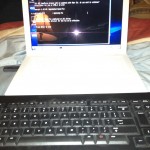It just works — with a few tweaks, non-standard tools and an external keyboard. When you go outside of Apple’s walled garden, a Macbook hardware install can be just as quirky and convoluted as any Windows machine.
After installing my new OCZ 240GB SSD in my Macbook, the performance was quicker, but not what I had come to expect from SSD’s, so I checked Activity Monitor, and it didn’t look good. The MB/s barely seemed to get into the triple digits.
Testing with Xbench confirmed that my drive was performing slower than expected, and System Information then revealed a Negotiated Link Speed of 1.5 GB/s instead of the standard SATA II 3.0 GB/s. It also revealed that TRIM was not enabled. I thought Lion supported TRIM natively. Whatever.
The drive had already been flashed to the latest firmware before installation. A scan of the OCZ forum revealed that luckily, about a month ago OCZ released a fix for the sub-optimal negotiated link speed here. As instructed, I downloaded the OCZ_MAC.ISO file, burned it to a CD-RW with Disk Utility, and booted to the CD. It’s a Linux boot CD with some apps installed, including an icon labeled “MAC 1.5/3G.” Upon clicking the upgrade icon, I was prompted to press ENTER to proceed, but it didn’t work. The keyboard was stuck in a numeric keypad mode, as if an invisible numlock had been engaged, and no key or key combination I could find mapped to ENTER. The LXTerminal wouldn’t let me type anything but numbers. I searched for some technical solutions to no avail, so I plugged in the USB keyboard I had in the room. It worked.
 After that and a cold boot, my Negotiated Link Speed went to 3.0GB/s, and my Xbench performance improved dramatically.
After that and a cold boot, my Negotiated Link Speed went to 3.0GB/s, and my Xbench performance improved dramatically.
Xbench Results Before:
Results 215.27 System Info Xbench Version 1.3 System Version 10.7.2 (11C74) Physical RAM 6144 MB Model MacBook5,2 Drive Type OCZ-AGILITY3 Disk Test 215.27 Sequential 131.29 Uncached Write 172.94 106.18 MB/sec [4K blocks] Uncached Write 163.59 92.56 MB/sec [256K blocks] Uncached Read 69.87 20.45 MB/sec [4K blocks] Uncached Read 234.73 117.97 MB/sec [256K blocks] Random 597.54 Uncached Write 814.37 86.21 MB/sec [4K blocks] Uncached Write 301.58 96.55 MB/sec [256K blocks] Uncached Read 1820.09 12.90 MB/sec [4K blocks] Uncached Read 624.64 115.91 MB/sec [256K blocks]
Xbench Results After:
Results 284.16 System Info Xbench Version 1.3 System Version 10.7.2 (11C74) Physical RAM 6144 MB Model MacBook5,2 Drive Type OCZ-AGILITY3 Disk Test 284.16 Sequential 167.64 Uncached Write 279.56 171.65 MB/sec [4K blocks] Uncached Write 290.05 164.11 MB/sec [256K blocks] Uncached Read 71.03 20.79 MB/sec [4K blocks] Uncached Read 362.48 182.18 MB/sec [256K blocks] Random 931.94 Uncached Write 1396.59 147.85 MB/sec [4K blocks] Uncached Write 531.30 170.09 MB/sec [256K blocks] Uncached Read 1629.62 11.55 MB/sec [4K blocks] Uncached Read 925.69 171.77 MB/sec [256K blocks]
That definitely makes things snappier. But what about enabling TRIM? A quick search revealed the command lines to make it work. So now, after analysis, benchmarking, searching, downloading an ISO image and burning a CD, booting to linux and updating some arcane SSD attribute that is not updatable using the standard firmware update tools from OCZ, using an external USB keyboard I just happened to have lying around, and using some obscure technical command line mojo, my SSD “just works.”
NVidia MCP79 AHCI:
Vendor: NVidia Product: MCP79 AHCI Link Speed: 3 Gigabit Negotiated Link Speed: 3 Gigabit Description: AHCI Version 1.20 Supported
OCZ-AGILITY3:
Capacity: 240.06 GB (240,057,409,536 bytes) Model: OCZ-AGILITY3 Revision: 2.150000 Serial Number: OCZ-72NG6Q7M4Y65990P Native Command Queuing: Yes Queue Depth: 32 Removable Media: No Detachable Drive: No BSD Name: disk0 Medium Type: Solid State TRIM Support: Yes Partition Map Type: GPT (GUID Partition Table) S.M.A.R.T. status: Verified Volumes: disk0s1: Capacity: 209.7 MB (209,715,200 bytes) BSD Name: disk0s1 Content: EFI OSX: Capacity: 239.71 GB (239,713,435,648 bytes) Available: 81.44 GB (81,442,209,792 bytes) Writable: Yes File System: Journaled HFS+ BSD Name: disk0s2 Mount Point: / Content: Apple_HFS
Now that the HD bottleneck is eliminated by the SSD, the CPU works harder. My always-visible Menu Meter CPU gauge showed me how much harder the CPU was working, which made the computer seem subjectively slower. I disabled it and took a deep breath — instant psychological upgrade! Overall, the SSD makes the old Macbook seem new again, but it would seem even newer if I’d had one of these cases to protect it from getting slightly bent in my backpack. Parallels runs much faster.
Don’t suppose you stil have that ocz_mac file?
Negatory. That iso is long gone from my storage. If you find it, let me know and I’ll give it a home.
Thanks, will keep looking and let your know if I do.